Customers are unpredictable! They visit online stores with their individual preferences and pathways. But with a customer journey map, businesses can better align their effort with customers’ needs.
A customer journey map represents a customer’s complete experience when going through and interacting with a business. The map functions as a road map for comprehending the requirements, desires, and problems of a client. So, it starts from a customer’s pre-purchase awareness and continues until the post-purchase process.
Customer trends and preferences are constantly changing, and your store must cope with them. That is why you need to look at your business and products from a customer’s viewpoint. However, a well-researched customer journey map can significantly enhance customer experience.
In this article, We will represent how you can create an effective customer journey map. Before diving into the main topic, we will discuss the types and necessities of a customer journey map.
Types of Customer Journey Map
Different customer journey maps reflect various customer activities because each customer interacts with a business differently. Moreover, consumers may interact with an online shop at any time that is convenient for them.
Customer journey maps vary based on a business’s customer requirements and objectives. For instance, a healthcare organization may concentrate on giving patients clear and understandable information. On the other hand, a retail shop will focus on developing a seamless in-store and online buying experience.
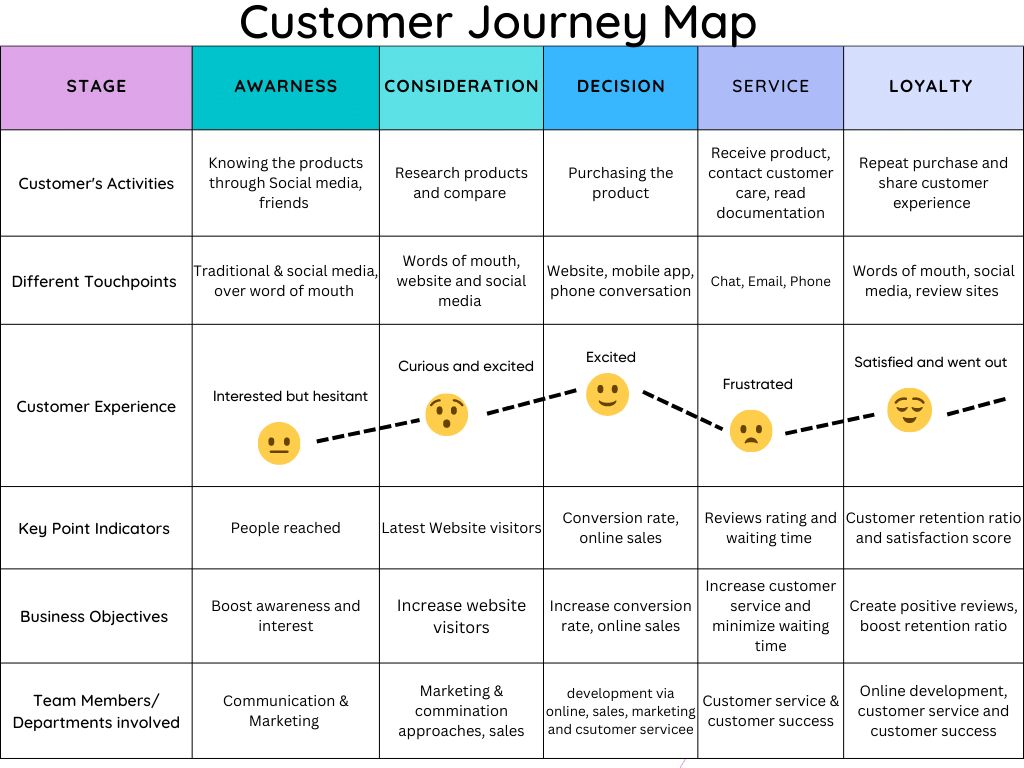
Different business industries also have different customer types and touchpoints. For example, B2B and B2C companies have different customer journeys. Moreover, the service industry also includes different customer journey maps compared to the product-based industry.
Based on the business, industry type, and customer lifestyle, there are 4 customer journey maps. You can choose one depending on your business type and objective.
Current State Customer Journey Map
The current state template is a customer journey map that is often used by most businesses. This map describes the present state of a customer experience as it is being provided right now. It visually represents the steps and touchpoints a customer goes through while interacting with an organization.
The current state template is ideal for finding flaws, inconsistencies, and chances for user experience enhancement. For example, you can create a current state template and track your customer’s journey from when they first learn about the business until the point of purchase and the follow-up period thereafter.
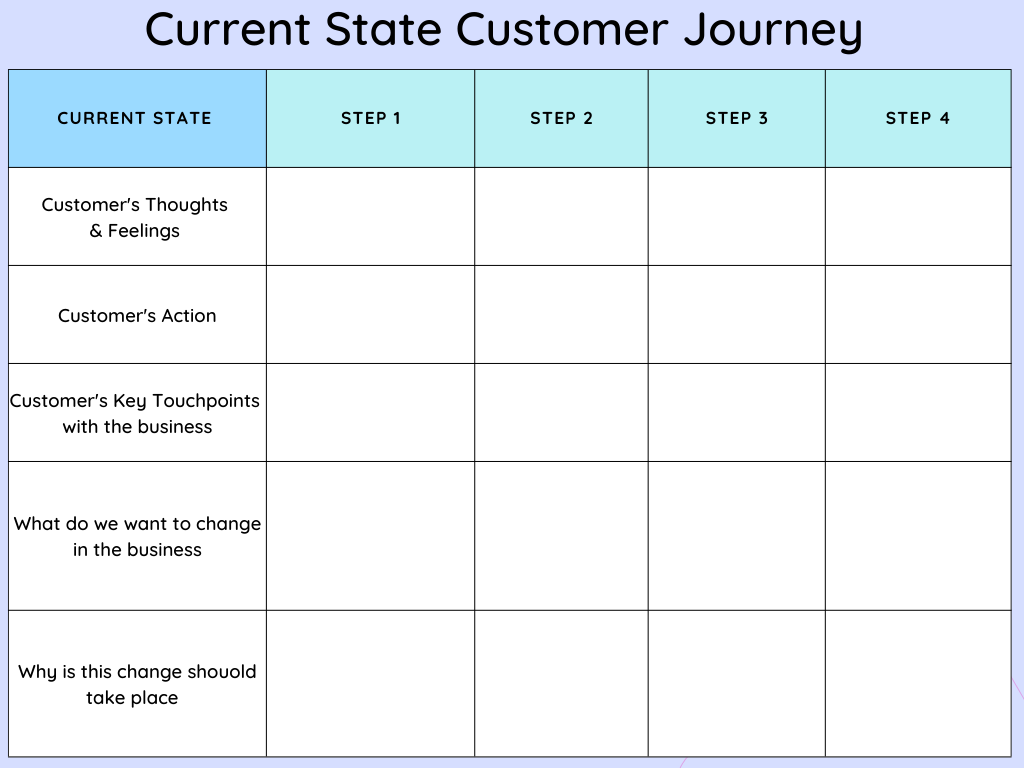
The current State template can find out the following touchpoints:
- Browsing the website
- Going to a physical store location
- Completing the purchase
- Interacting with customer support
Future State Customer Journey Map
Using the future state template, you can envision the customer experience at your business in the future. By experience, we mean the ideas, activities, and feelings that your customers will encounter.
This template aids in developing the ideal client journey with your brand. It is crucial to first comprehend the present consumer experience via research. Therefore, you must first create the current state map and then design the future state. First, you must pinpoint the areas of development and establish specific objectives for the future.

Additionally, the future state template binds teams and stakeholders with a common goal. It helps launch a new product leading to more efficient and effective decision-making.
Future State template can find out the following touchpoints:
- Explore Digital channels such as websites and mobile apps
- Physical locations such as stores and branches
- Different advertising campaigns for the future
- Team member & stakeholder coordination
- Improving post-purchase experiences
Day In The Life Customer Journey Map
Day in the life customer journey map visually portrays a customer’s journey on a typical day with a business. The map emphasizes the existing problems in the lives of your current and potential customers. As a result, you can discover fresh approaches to spur innovation and satisfy customers’ shifting demands.
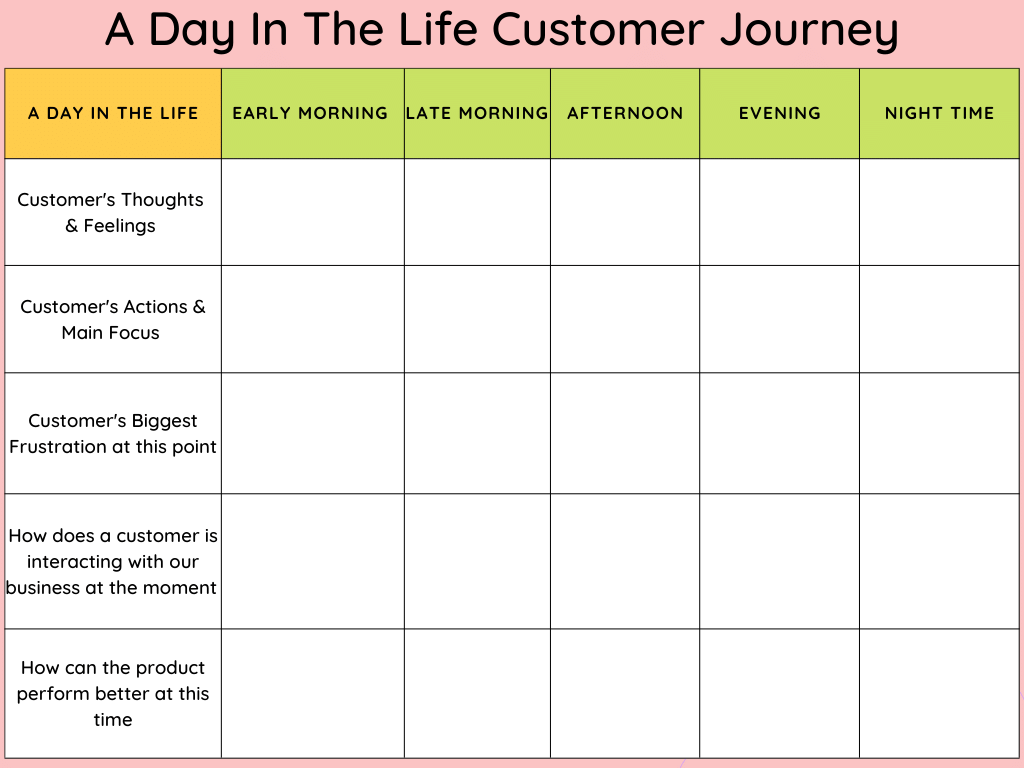
It often contains details on customers’ locations, certain product or service usage, and demographics. Therefore, you can tactically adapt your communication strategy and engage them right where they are. Then you can offer them at the precise time when they’re ready to purchase.
Service Blueprint Customer Journey Map
Service Blueprint combines the customer journey with the business journey and works as additional content. The objective of this map is to see each stage through the eyes of the client and propose modifications to the service when necessary.
The foundation of this map is based on any of the other three maps. Afterward, It is layered to deliver an enhanced customer experience. This map will assist you in forecasting the following aspects:
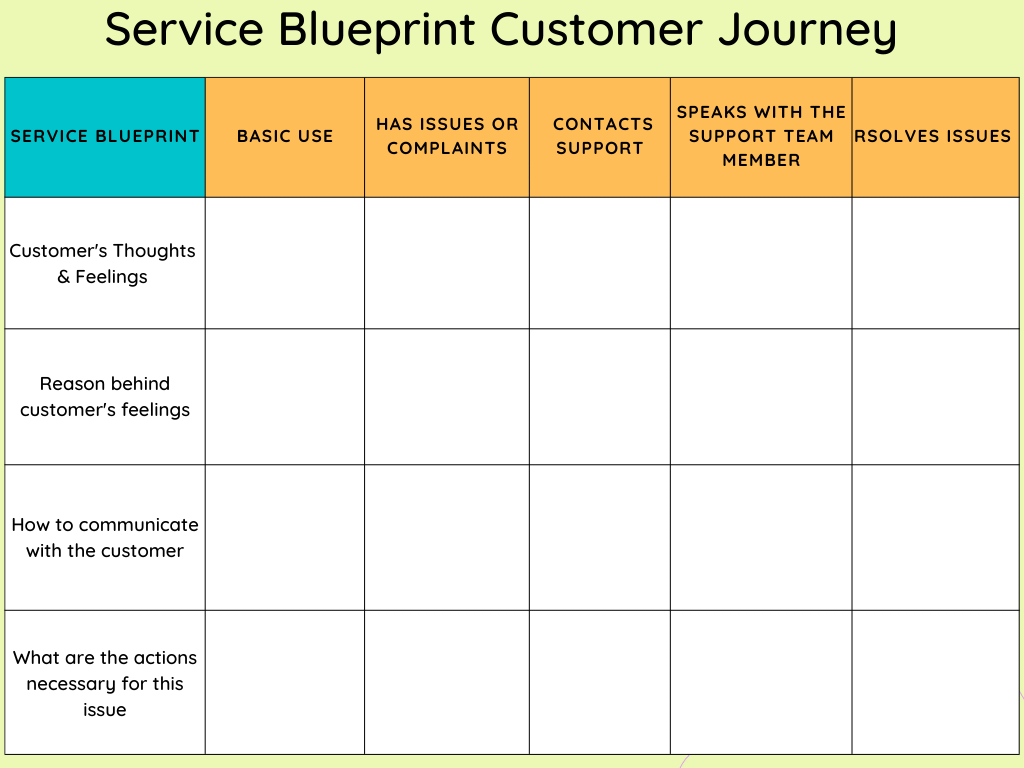
- Where your customers will be in the future
- Where will they be in terms of requirements?
- How will they benefit from your product and service?
Reasons to have a Customer Journey Map
According to statistics, 86% of customers are prepared to pay extra for a better customer experience. But an effective customer journey map will allow you to enhance the customer experience massively.
Nowadays, customers are concerned, picky, and willing to have a smooth relationship with a business. They anticipate that businesses will allocate their demands and remember their actions. So they can return to your store anytime and continue shopping from where they left off.
Let’s take a closer look at the reasons to have a customer journey map:
- Enhance Customer Experience: At every step of a customer journey, you will understand your customer’s requirements. It will help you enhance the customer experience.
- Sales & Revenue Growth: By addressing and resolving consumer pain points, businesses can improve customer experience. Thus, your sales and revenue will grow.
- Improved Product or Service Design: A customer journey map can guide businesses in creating goods and services that better satisfy the requirements of their target market. Hence, customers will feel more satisfied and become loyal.
- Better Marketing and Communication: Businesses can take more emphasis on marketing and communication efforts by knowing the client journey. As a result, customers will become more engaged, and conversion rates will rise.
- Stronger Team Collaboration: Teams from different departments, including marketing, sales, and customer support, will benefit from a customer journey map. Because a team will get a chance to work together to understand the customers’ needs better.
- Cost-Effective Processes: Businesses can improve their processes and save costs by discovering bottlenecks and inefficiencies in the customer journey.
- Wise Decision Making: A customer journey map can provide insightful information guiding decision-making at different organizational levels.
- Defending The Future: By using a customer journey map, businesses can plan for and identify shifts in the market, consumer preferences, and technological advancements. So you can customize your business and influence the customer’s journey.
A successful customer journey map gives a clear insight into what your customer is looking for at your business. Also, it reveals the improvement opportunities for your brand, products, and services.
Creating a Customer Journey Map
Each customer journey map will vary depending on the approach and tools you use. Remember that every client is different, as well as the customer journey map. But we’ll walk you through the fundamentals of making a customer journey map to make things clearer.
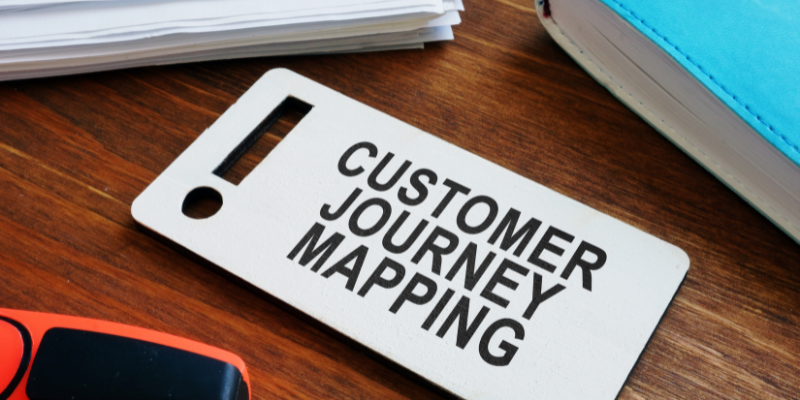
#1. Determine The Target Customer
This phase entails figuring out your ideal client and learning about their characteristics, habits, and problems. Surveying the customers and market research can be utilized to get this data.
After getting the data, use it to define your target customers and adapt your customer journey map. For instance, you may employ customer segmentation strategies. Then you can put consumers into groups according to their demographics, past purchase, or other factors. In this way, you can meet the particular demands of your customer.
#2. Obtain Customer Data
In this stage, you gather data on customers’ interactions with your business. This data will include the customer’s key touchpoints and their frustration. You can implement surveys, interviews, and customer service logs. You can use this data to create a flawless presentation of the customer journey.
To get data from different groups of customers, you can combine the quantitative and qualitative methods. For that reason, you can implement online surveys and customer interviews.
#3. Organize the Gathered Data
At this stage, you need to put the information you’ve gathered into a visual style using a timeline or flowchart. You will be able to comprehend the client journey in a clearer, more succinct way with this representation.
Using a flowchart, you can show the different stages of the customer journey and touchpoints at each stage.
#4. Pinpoint The Key Touchpoints
The objective of this stage is to identify the crucial customer touchpoints, such as the first interaction, the decision-making process, and the post-purchase experience. These touchpoints are crucial for comprehending the customer experience and identifying improvement opportunities.
For instance, you may identify the touchpoints where customers are most likely to have issues or lose interest. To get this data, you can explore the analytics data and customer feedback.
#5. Analysis Customer Activities
To comprehend the demands and pain points of the client, this stage entails searching for patterns and insights in the data. You can use this study to pinpoint areas where the customer experience might need enhancement.
For example, to find the patterns in consumer behavior and comments, you can utilize statistical analysis methods such as clustering or factor analysis.
#6. Creating Buyers Persona
Using the data you’ve gathered in previous steps, develop customer personas at this stage. Your customer journey map will be more effective using these personas because you can represent various consumer base segments.

In contrast, you can develop personas for various consumer categories, such as early adopters or price-sensitive shoppers. This will assist you in better understanding your customer’s particular needs and preferences.
#7. Include Emotions
You need to add emotions to your customer journey map to understand your customer’s feelings at different points in the journey. Then use this information to make adjustments that better serve customers’ demands and design a customer experience that is more sympathetic to their wants.

For example, you can utilize consumer feedback and interviews to pinpoint feelings like annoyance, confusion, or satisfaction connected to various touchpoints.
#8. Discover Areas of Improvement
This step enables you to use the insights collected from the analysis and emotions to identify the scopes for improvement in the customer journey. Customer feedback or analytics data are useful to identify customer pain points at this stage.
Additionally, identify the issues where customers are dropping off. Finally, brainstorm the potential solution to resolve the problems.
#9. Develop A Strategy For Action
Now, it’s time to create an action plan to address the areas that can be improved and alter the customer journey. This strategy needs to include precise actions to be performed, as well as deadlines & roles.
You can, for instance, develop a project plan that outlines a schedule for putting changes into practice. Also, the plan should specify duties for each team member and a strategy to determine if the changes were successful.
#10. Test And Optimize
It’s time to put the modifications you’ve made to the customer’s journey to the test and get client feedback. The journey gets further improved and refined due to this input. To determine how consumers would react to journey modifications, convey A/B testing.
Moreover, you can collect customer feedback via surveys or customer service contacts. This way, you can see how the changes affect their satisfaction and engagement. When you have this feedback, use it to modify the customer journey further and ensure it satisfies the customer demands and advances the business objectives.
Common Mistakes To Avoid
The power of customer journey mapping should be clear for you to understand at this point.
Customer journey mapping creates a solution that you must use adequately to enhance customer experience and get the desired outcome.
Furthermore, adhering to the best mapping methods is not enough to acquire success in a project. It’s essential to avoid the common mistakes that might make your project a failure.
To create a successful customer journey mapping, these are the common mistakes to avoid:
- Starting a customer journey mapping without specifying the goals.
- Ignoring the whole customer journey and only focusing on how customers are connecting to your product or service.
- Taking feedback only from loyal customers and avoiding non-loyal ones.
- Not focusing on the early stages of a customer’s demands
- Overlooking the emotional components of a customer’s journey.
- Not getting different departments and stakeholders involved in the mapping process.
- Not updating or reevaluating the journey map
- Not putting the map through any kind of consumer validation process.
- Failure to use several data sources to comprehend the customer’s experience fully.
- Not highlighting areas for improvement to make the map more actionable.
- Forgetting to consider the customer’s post-purchase experience
We strongly advise you to avoid the pitfalls listed above.
Customer Journey Mapping Tools
To ease out your customer journey mapping process, you can check out the following tools:
#1. Miro
Miro is a tool that provides a balance of structure & flexibility. You can improve customer experience with proper visualization and team collaboration. It lets you focus on what is essential and helps you create a smooth customer journey map.
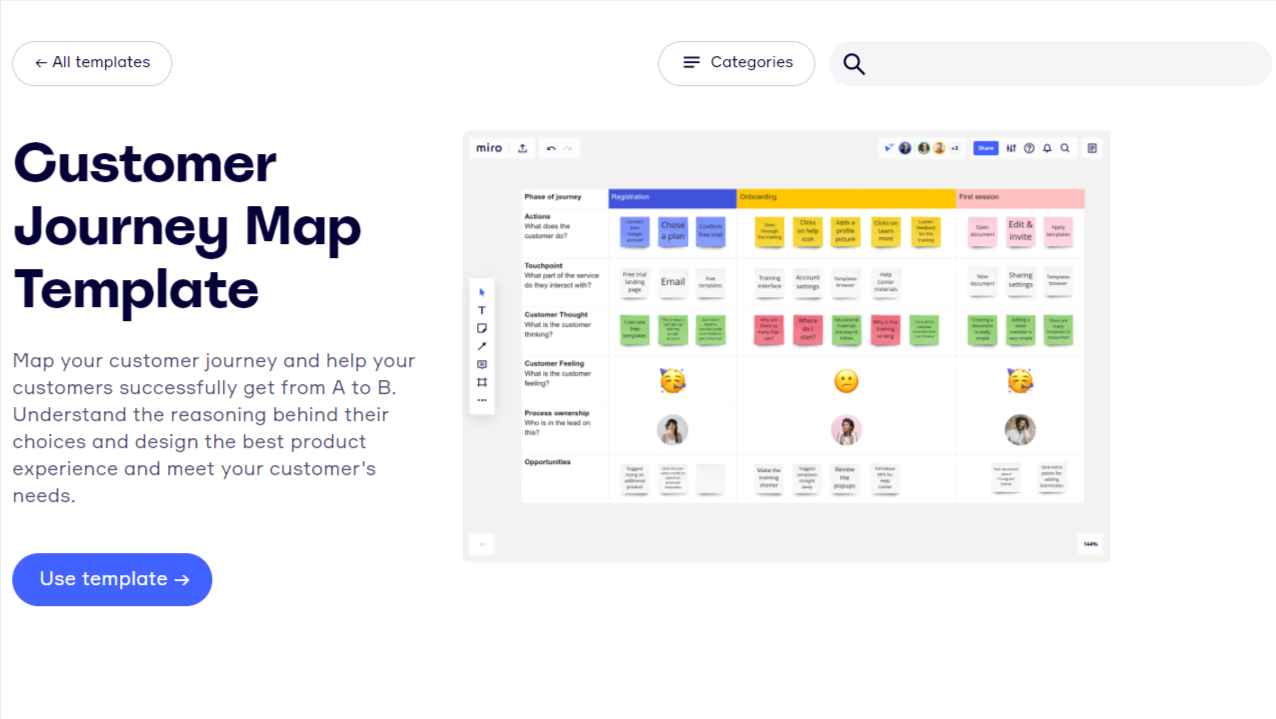
Features:
- Multiple users can work together on the same customer journey map simultaneously
- Customizable customer journey map templates are available.
- Visually represents the product or service knowledge across different departments
- Identify customer pain points, cultivate empathy, and create solutions with team effort
- Accelerates the team’s process by clearly showing customer journey, touchpoints, personas, and more
- Cloud-based customer journey mapping tool
- Sharable customer journey map information
#2. UXPressia
UXPressia makes the customer journey mapping process seamless with some amazing features.
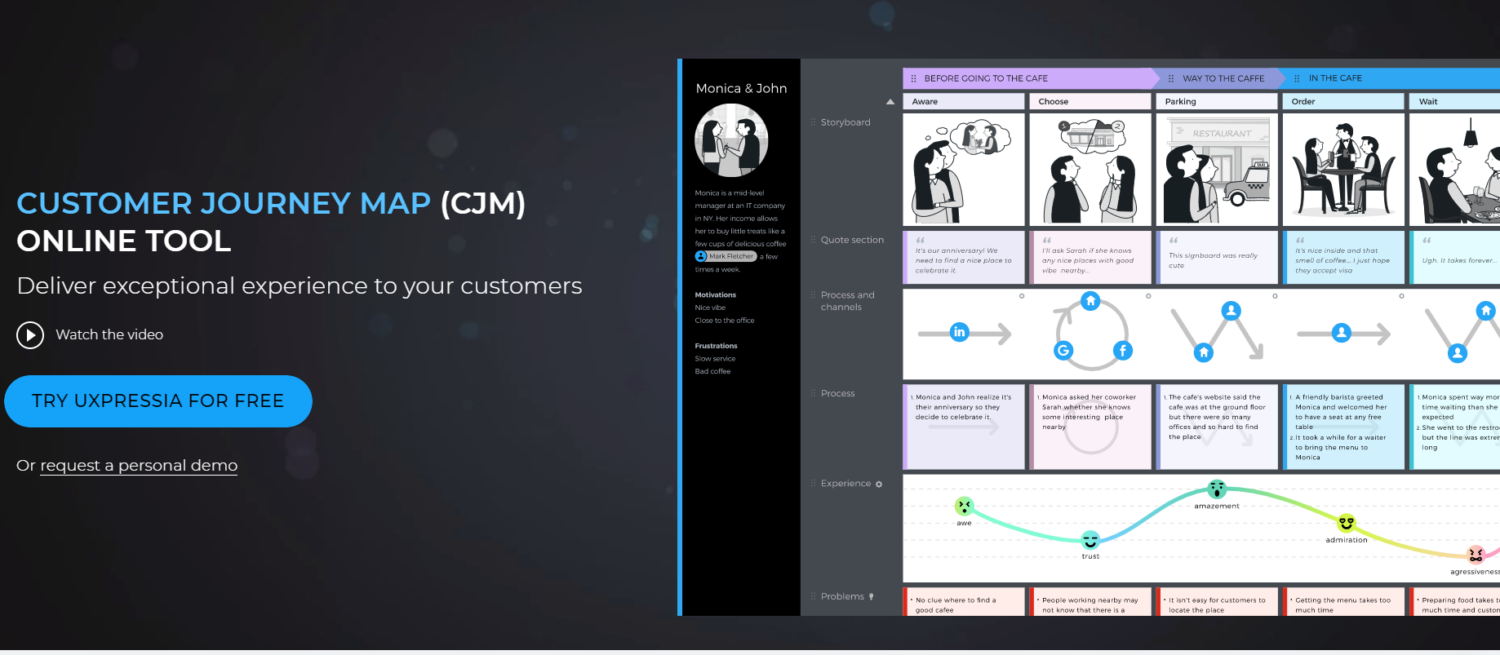
Features:
- Real-time collaboration with team members, stakeholders, and clients.
- Omni-channel experience that shows customer experience in different touchpoints.
- Visualize customer emotions using experience graph at different steps
- Export customer experience maps into print-ready and customizable file formats
- Get accurate analytics data on the customer journey map
- Get 60+ templates to represent customer journey map
We’ve listed a few customer journey mapping software, but you can explore more tools online.
FAQs
1. Buyers persona of the customer
2. Stages of Customer’s buying journey
3. Customer Touchpoints
4. Customer Emotions
Detailed information on customers
Customers’ key touchpoint with your business
Information on customers’ decision-making process
Customers’ Feedback
Other brands and products your customers are considering
Customers’ post-purchase activities
Final Thoughts
Customers are dynamic, and their journey is constantly shifting toward new trends. But if you have a customer journey map, you can keep track of your client’s ever-changing demands. You will get an analytical visual representation of different customers in one spot. Therefore, it becomes easier to maintain a customer-centered attitude.
Different customers pose a different journey map, but the steps are always the same. We have tried out best to assist you and inform you of those steps in this article. You just need to go through those steps and create a journey map yourself. It will significantly help you eliminate obstacles and develop an enhanced customer experience.
Si quiere puede hacernos una donación por el trabajo que hacemos, lo apreciaremos mucho.
Direcciones de Billetera:
- BTC: 14xsuQRtT3Abek4zgDWZxJXs9VRdwxyPUS
- USDT: TQmV9FyrcpeaZMro3M1yeEHnNjv7xKZDNe
- BNB: 0x2fdb9034507b6d505d351a6f59d877040d0edb0f
- DOGE: D5SZesmFQGYVkE5trYYLF8hNPBgXgYcmrx
También puede seguirnos en nuestras Redes sociales para mantenerse al tanto de los últimos post de la web:
- Telegram
Disclaimer: En Cryptoshitcompra.com no nos hacemos responsables de ninguna inversión de ningún visitante, nosotros simplemente damos información sobre Tokens, juegos NFT y criptomonedas, no recomendamos inversiones

